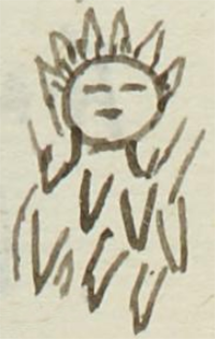Cipac (MH653r)
This black and white drawing of the glyph for the personal name Cipac ("Crocodile" or "Crocodilian Monster," attested here as a man's name) shows an unusual representation of the crocodile with an anthropomorphic face in a frontal view. It is reminiscent of some representations of teotl.
Stephanie Wood
This name is a day sign. Originally, a name like this would have a number attached to it. But calendrical names were evolving at the time of this manuscript (1560), often dropping their numbers. This day sign comes from the tonalpohualli, the 260-day divinatory calendar. Calendrics figure importantly in Nahuas' religious views of the cosmos. The thirteen-day cycle that was started by One-Cipactli was an auspicious time to be born according to a downloadable publication hosted by Mexicolore.
Perhaps this stylized version of the cipactli (alligator, crocodile, or caiman) is meant to disguise that the family who named their baby this were still consulting the calendar, a practice that some friars had hoped to root out. The crocodile was a double for the divine force or deity, Tonacatecuhtli, creator of the universe and the human race, according to Anastasia Kalyuta, also publishing in Mexicolore. This glyph may represent that divine force instead of the crocodile.
Stephanie Wood
andres tzipac
Andrés Cipac
Stephanie Wood
1560
Jeff Haskett-Wood
animales, cocodrilos, cocodrilo, caiman, caimanes, cipactli, teotl, fechas, nombres de hombres, calendarios, nombres de dias

cipac(tli), crocodile or crocodilian monster, https://nahuatl.wired-humanities.org/content/cipactli
Cocodrilo o Caiman
Stephanie Wood
Matrícula de Huexotzinco, folio 653r, World Digital Library, https://www.loc.gov/resource/gdcwdl.wdl_15282/?sp=388&st=image
This manuscript is hosted by the Library of Congress and the World Digital Library; used here with the Creative Commons, “Attribution-NonCommercial-ShareAlike 3.0 License” (CC-BY-NC-SAq 3.0).











